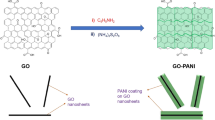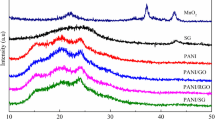Abstract
Polyaniline (PANI) has been widely used for the energy storage applications either as a conducting agent or directly as an electroactive material due to the tunable pseudocapacitive performance owing to its various oxidation states. Nanocomposites including PANI, PANI/graphene oxide (PANI/GO), and PANI/GO/Cr-MOF were synthesized via a novel in situ chemical oxidative polymerization method including two oxidants. The structure and morphology of composites were characterized by Fourier-transform infrared spectroscopy (FTIR), X-ray diffraction (XRD), field-emission scanning electron microscopy (FE-SEM), and transmission electron microscopy (TEM) measurements. Furthermore, PANI, PANI/GO, and PANI/GO/Cr-MOF were assembled as positive electrode materials into a button-type supercapacitor for electrochemical performance testing; the electrochemical performances of the composites were characterized by cyclic voltammetry (CV), galvanostatic charge–discharge (GCD), and electrochemical impedance spectroscopy (EIS) techniques in detail. The ASC (asymmetric supercapacitors) possessed an extended potential window (0.8 V), an extraordinary specific capacitance (243.125 F/g at 0.5 A/g, 243 F/g at 1 A/g, and 242.5 F/g at 2 A/g, and these data fully demonstrate that this material has excellent rate performance), a remarkable cycling property (90.72% capacitance retention after 5000 cycles), and a satisfactory average energy and power density (21.56 wh/kg and 3.6 kW/kg).









Similar content being viewed by others
References
Nuramdhani I, Gokceoren AT, Odhiambo SA, De MG, Hertleer C, Van LL (2018) Electrochemical impedance analysis of a pedot:pss-based textile energy storage device. Materials 11:48
Ciric-Marjanovic G (2013) Recent advances in polyaniline composites with metals, metalloids and nonmetals. Synth Met 170:31–56
Xia C, Guo J, Lei Y, Liang H, Zhao C, Alshareef HN (2017) Rechargeable aqueous zinc-ion battery based on porous framework zinc pyrovanadate intercalation cathode. Adv Mater 30(5):1–7
Yan J, Tong W, Fan Z et al (2010) Preparation of graphene nanosheet/carbon nanotube/polyaniline composite as electrode material for supercapacitors. J Power Sources 195(9):3041–3045
Jiang H, Lee PS, Li C (2012) 3D carbon based nanostructures for advanced supercapacitors. Energy Environ Sci 6(1):41–53
Zheng FL, Li GR, Ou YN et al (2010) Synthesis of hierarchical rippled Bi2O3 nanobelts for supercapacitor applications. Chem Commun 46(27):5021–5023
Zhou G, Wang D, Feng L et al (2011) The effect of carbon particle morphology on the electrochemical properties of nanocarbon/polyaniline composites in supercapacitors. New Carbon Mater 26(3):180–186
Huang H, Gan M, Ma L, Yu L, Hu H, Yang F, Li Y, Ge C (2015) Fabrication of polyaniline/graphene/titania nanotube arrays nanocomposite and their application in supercapacitors. J Alloys Compd 630:214–221
Eftekhari A, Li L, Yang Y (2017) Polyaniline supercapacitors. J Power Sources 347:86–107
Xia C, Leng M, Tao W et al (2019) Polyaniline/carbon nanotube core–shell hybrid and redox active electrolyte for high-performance flexible supercapacitor. J Mater Sci: Mater Electron 30(5):4427–4436
Lyu C, Huang Z, Li H et al (2019) Distributed control for state-of-energy balancing of supercapacitor modules in light rail vehicles. IEEE Trans Vehicular Technol PP(99):1–1
Wang G, Zhang L, Zhang J (2012) A review of electrode materials for electrochemical supercapacitors. Chem Soc Rev 41(2):797–828
Durairaj A, Sakthivel T, Ramanathan S et al (2019) Conversion of laboratory paper waste into useful activated carbon: a potential supercapacitor material and a good adsorbent for organic pollutant and heavy metals. Cellulose 26(5):3313–3324
Kumar V, Wang X, Lee PS (2015) Formation of hexagonal-molybdenum trioxide (h-MoO3) nanostructures and their pseudocapacitive behavior. Nanoscale 7(27):11777–11786
Vighnesha KM, Shruthi S et al (2018) Synthesis and characterization of activated carbon/conducting polymer composite electrode for supercapacitor applications. J Mater Sci: Mater Electron 29(2):914–921
Diaz A, Logan J (1980) Electroactive polyaniline films. Electroanal Chem Interf Electrochem 1(111):111–114
Chacko A, Jin Y, Shi Y et al (2018) Advances in reliability of conducting polymers and conducting polymer based capacitors in high humidity environment. ECS Trans 85(13):115–127
Xu L, Liu R, Wang F et al (2019) Preparation of triazine containing porous organic polymer for high performance supercapacitor applications. RSC Adv 9(3):1586–1590
Rudge A, Raistrick I, Gottesfeld S, Ferraris JP (2015) A study of the electrochemical properties of conducting polymers for application in electrochemical capacitors. Electrochim Acta 39(2):273–287
Candelaria SL, Shao Y, Zhou W, Li X, Xiao J, Zhang J, Wang Y, Liu J, Li J, Cao G (2012) Nanostructured carbon for energy storage and conversion. Nano Energy 1(2):195–220
Wang J, Zhang H, Hunt MRC et al (2017) Synthesis and characterisation of reduced graphene oxide/bismuth composite for electrodes in electrochemical energy storage devices. Chemsuschem 10(2):363–371
Cai G, Park S, Cheng X et al (2018) Inkjet-printed metal oxide nanoparticles on elastomer for strain-adaptive transmissive electrochromic energy storage systems. Sci Technol Adv Mater 19(1):759–770
Zhang L, Huang D, Hu N et al (2017) Three-dimensional structures of graphene/polyaniline hybrid films constructed by steamed water for high-performance supercapacitors. J Power Sources 342:1–8
Nethravathi C, Rajamathi CR, Rajamathi M et al (2014) Cobalt hydroxide/oxide hexagonal ring–graphene hybrids through chemical etching of metal hydroxide platelets by graphene oxide: Energy storage applications. ACS Nano 8(3):2755–2765
Patil JV, Mali SS, Kamble AS et al (2017) Electrospinning: a versatile technique for making of 1D growth of nanostructured nanofibers and its applications: an experimental approach. Appl Surf Sci 423:641–674
Hu H, Liu S, Hanif M, Chen S, Hou H (2014) Three-dimensional cross-linked carbon network wrapped with ordered polyaniline nanowires for high-performance pseudo-supercapacitors. J Power Sources 268:451–458
Ramkumar R, Sundaram MM (2016) Electrochemical synthesis of polyaniline cross-linked NiMoO4 nanofibre dendrites for energy storage devices. New J Chem 40(9):7456–7464
Malik R, Zhang L, Mcconnell C et al (2017) Three-dimensional, free-standing polyaniline/carbon nanotube composite-based electrode for high-performance supercapacitors. Carbon 116:579–590
Liu P (2017) Polyaniline/multi-walled carbon nanotubes composite with core-shell structures as a cathode material for rechargeable lithium-polymer cells. Appl Surf Sci 400:446–452
Ghanbari K (2007) Synthesis of polyaniline/graphite composite as a cathode of Zn-polyaniline rechargeable battery. J Power Sources 170(2):513–519
Ates M, El-Kady M, Kaner RB (2018) Three-dimensional design and fabrication of reduced graphene oxide/polyaniline composite hydrogel electrodes for high performance electrochemical supercapacitors. Nanotechnol 29(17):175402
Li R, Yang Y, Wu D et al (2019) Covalent functionalization of reduced graphene oxide aerogels with polyaniline for high performance supercapacitors. Chem Commun 12:1671–1846
Xie A, Feng T, Peiwu C et al (2018) Synthesis and supercapacitive properties of carboxylated graphene oxide -polyaniline/polypyrrole nanocomposites. J Electrochem Soc 165(7):H291–H299
Qi K, Hou R, Zaman S et al (2018) Construction of metal-organic framework/conductive polymer hybrid for all-solid-state fabric supercapacitor. ACS Appl Mater Interfaces 10(21):18021–18028
Xia W, Qu C, Liang Z et al (2017) High-performance energy storage and conversion materials derived from a single metal-organic framework/graphene aerogel composite. Nano Lett 17(5):2788–2795
Du W, Bai YL, Xu J et al (2018) Advanced metal-organic frameworks (MOFs) and their derived electrode materials for supercapacitors. J Power Sources 402:281–295
Ji C, Yao B, Li C, Shi G (2013) An improved hummers method for eco-friendly synthesis of graphene oxide. Carbon 64:225–229
Guerrero-Contreras J, Caballero-Briones F (2015) Graphene oxide powders with different oxidation degree, prepared by synthesis variations of the hummers method. Mater Chem Phys 153:209–220
Zhang LL, Zhao X, Stoller MD, Zhu Y, Ji H, Murali S, Wu Y, Perales S, Clevenger B, Ruoff RS (2012) Highly conductive and porous activated reduced graphene oxide films for high-power supercapacitors. Nano Lett 12(4):1806–1812
Ma B, Zhou X, Bao H, Li X, Wang G (2012) Hierarchical composites of sulfonated graphene-supported vertically aligned polyaniline nanorods for high-performance supercapacitors. J Power Sources 215
Golikand AN, Bagherzadeh M, Shirazi Z (2017) Evaluation of the polyaniline based nanocomposite modified with graphene nanosheet, carbon nanotube, and pt nanoparticle as a material for supercapacitor. Electrochim Acta 247
Lu Q, Chen Y, Li W et al (2013) Ordered mesoporous nickel cobaltite spinel with ultra-high supercapacitance. J Mater Chem A 1(6):2331–2336
Grote F, Yu ZY, Wang JL et al (2015) Self-stacked reduced graphene oxide nanosheets coated with cobalt-nickel hydroxide by one-step electrochemical deposition toward flexible electrochromic supercapacitors. Small 11(36):4666–4672
Chen LF, Yu ZY, Wang JJ et al (2015) Metal-like fluorine-doped β-FeOOH nanorods grown on carbon cloth for scalable high-performance supercapacitors. Nano Energy 11:119–128
Cong HP, Ren XC, Wang P et al (2013) Flexible graphene-polyaniline composite paper for high-performance supercapacitor. Energy Environ Sci 6(4):1185–1191
Xu Y, Hennig I, Freyberg D et al (2014) Inkjet-printed energy storage device using graphene/polyaniline inks. J Power Sources 248:483–488
Author information
Authors and Affiliations
Corresponding author
Rights and permissions
About this article
Cite this article
Han, JJ., Yan, Qr., Chen, Zw. et al. Application of Cr-metal organic framework (MOF) modified polyaniline/graphene oxide materials in supercapacitors. Ionics 28, 2349–2362 (2022). https://doi.org/10.1007/s11581-022-04443-4
Received:
Revised:
Accepted:
Published:
Issue Date:
DOI: https://doi.org/10.1007/s11581-022-04443-4




